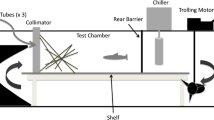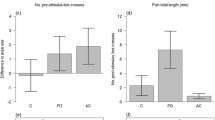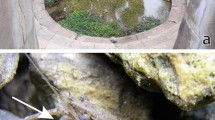Abstract
We initiated the use of a replicated, remote-video, artificial stream system to determine the effects of conspecific cue, refuge availability, and day/night conditions on movement, aggression, dominance, downstream preference, and refuge use by the crayfish Procambarus clarkii. In line with previous research, we found that walking on the gravel substrate was greatly increased and refuge use decreased in the dark. Conspecific cue (macerated crayfish filtrate) increased walking, contrary to our prediction but consistent with cue as a signal of food availability or of risk either from cannibalism or from visual predators. Exposure to conspecific cue in the streams resulted in a reduced degree of dominance in subsequent pairwise dominance trials. We developed and implemented a new and broadly applicable way of determining the extent of linearity (consistency of dominance ranks) for incomplete dominance; for our data, this method found a lack of evidence for linear hierarchies in these stream systems. Our results suggest that streams may tend to feature weaker dominance and reduced linearity of social hierarchies, relative to standing-water systems, a hypothesis that requires further testing.





Similar content being viewed by others
Data availability
The data that support the findings of this study are available from the corresponding author upon reasonable request.
References
Albertson LK, Daniels MD (2018) Crayfish ecosystem engineering effects on riverbed disturbance and topography are mediated by size and behavior. Freshwat Sci 37:836–844
Anastacio PM, Correia AM, Menino JP, da Silva LM (2005) Are rice seedlings affected by changes in water quality caused by crayfish? Annales De Limnologie—Internat. J Limnol 41:1–6
Angeler DG, Sánchez-Carrillo S, García G, Alvarez-Cobelas M (2001) The influence of Procambarus clarkii (Cambaridae, Decapoda) on water quality and sediment characteristics in a Spanish floodplain wetland. Hydrobiologia 464:89–98
Appleby MC (1983) The probability of linearity in hierarchies. Anim Behav 31:600–608
Bergman DACN, Redman KC, Fero JL, Simon PA, Moore (2006) The impacts of flow on chemical communication strategies and fight dynamics of crayfish. Mar Freshwat Behav Physiol 39:245–258
Chase ID, Tovey C, Spangler-Martin D, Manfredonia M (2002) Individual differences versus social dynamics in the formation of animal dominance hierarchies. Proc Nat Acad Sci USA 99:5744–5749
Chibucos K, Wofford SJ, Moore PA (2015) Hierarchical decision making: resource distribution exhibits stronger effect on crayfish dominance relationships and shelter occupation than prior social experience and resource ownership. Behaviour 152:1063–1082
Clark JL, Moore P (2018) The role of sensory modalities in producing nonconsumptive effects for a crayfish bass predator-prey system. Canad J Zool 96:680–691
Cole BJ (1981) Dominance hierarchies in Leptothorax ants. Science 212:83–84
Costa JR, Dalosto MM, Palaoro AV et al (2016) Contest duration and dynamics are affected by body size in a potentially subsocial crayfish (Crustacea: Decapoda). Ethology 122:502–512
Creed RP, Reed JM (2004) Ecosystem engineering by crayfish in a headwater stream community. J N Amer Benthol Soc 23:224–236
Creed RP, Taylor A, Pflaum JR (2010) Bioturbation by a dominant deteritivore in a headwater stream: Litter excavation and effects on community structure. Oikos 119:1870–1876
Dickey BF (2004) The behavioral ecology of the social structures of crayfish. Dissertation, University of Kentucky
Edwards DD, Rapin KE, Moore PA (2018) Linking phenotypic correlations from a diverse set of laboratory tests to field behaviors in the crayfish Orconectes virilis. Ethology 124:311–330
Fořt M, Shakhawate MS, Hossain A, Kouba M, Buřič M, Kozák P (2019) Agonistic interactions and dominance establishment in three crayfish species non-native to Europe. Limnologica 74:73–79
Gaston KJ (2019) Nightime ecology: the “nocturnal problem” revisited. Amer Natur 193:481–502
Gavioli A, Milardi M, Lanzoni M et al (2018) Managing the environment in a pinch: red swamp crayfish tells a cautionary tale of ecosystem based management in northeastern Italy. Ecol Engin 120:546–553
Gherardi F, Barbaresi S, Salvi G (2000) Spatial and temporal patterns in the movements of Procambarus clarkii, an invasive crayfish. Aquat Sci 62:179–193
Gherardi F, Mavuti KM, Pacini N, Tricarico E, Harper DM (2011) The smell of danger: chemical recognition of fish predators by the invasive crayfish Procambarus clarkii. Freshw Biol 56:1567–1578
Glon MG, Reisinger LS, Pintor LM (2018) Biogeographic differences between native and non-native populations of crayfish alter species coexistence and trophic interactions in mesocosms. Biol Invas 20:3475–3490
Groza MI, Pop-Vancia V, Miresan V (2016) Diel activity and use of multiple artificially constructed shelters in Astacus leptodactylus (Decapoda: Astacidae). Biologia (Bratislava) 71:1369–1379
Gruber C, Tulonen J, Kortet R (2016) Resource availability and predation risk influence contest behavior and dominance hierarchies in crayfish. Behav Ecol Sociobiol 70:1305–1317
Hazlett BA (2010) Chemical cues and reducing the risk of predation. In: Breithaupt T, Thiel M (eds) Chemical Communication in Crustaceans. Springer, New York
Herberholz J, Swierzbinski ME, Birke JM (2016) Effects of different social and environmental conditions on established dominance relationship in crayfish. Biol Bull 230:152–164
Hernando HO (2018) Circadian rhythms of omitted stimulus potentials in the crayfish brain. Biol Rhythm Res 49:141–150
Hirsch PE, Burkhardt-Holm P, Toepfer I et al (2016) Movement patterns and shelter choice of spiny-cheek crayfish (Orconectes limosus) in a large lake’s littoral zone. Aquat Invas 11:55–65
Ilhéu M, Acquistapace P, Benvenuto C, Gherardi F (2003) Shelter use of the Red-Swamp Crayfish (Procambarus clarkii) in dry-season stream pools. Arch. Hydrobiol. Stuttgart, pp 1–12
Jimenez-Morales N, Mendoza-Angeles K, Porras-Villalobos M et al (2018) Who is the boss? Individual recognition memory and social hierarchy formation in crayfish. Neurobiol Learn Memory 147:79–89
Jurcak AM, Moore PA (2018) Sensory signals and the reaction space in predator-prey interactions. Hydrobiologia 816:137–152
Kenison EK, Weldy PY, Williams RN (2018) There must be something in the water: Assessing the behavioral responses of rusty crayfish (Orconectes rusticus) to fish and amphibian predator kairomones. J Ethol 36:77–84
Klar NM, Crowley PH (2011) Shelter availability, occupancy, and residency in size-asymmetric contests between rusty crayfish, Orconectes rusticus. Ethology 118:118–126
Kubec JA, Kouba M, Buřič M (2019) Communication, behavior, and decision making in crayfish: a review. Zoologischer Anzeiger 278:28–37
Kuklina IF, Ložek P, Císař A, Kouba P, Kozák P (2018) Crayfish can distinguish between natural and chemical stimuli as assessed by cardiac and locomotor reactions. Envir Sci Pollut Res 25:8396–8403
Linzmaier SM, Goebel LS, Ruland F, Jeschke JM (2018) Behavioral differences in an over-invasion scenario: marbled vs spiny-cheek crayfish. Ecosphere 9:e02385
Ludlam JP, Magoulick DD (2010) Effects of consumer identity and disturbance on stream mesocosm structure and function. Fund Appl Limnol 177:143–149
Martin AI, Moore PA (2007) Field observations of agonism in the crayfish, Orconectes rusticus: shelter use in a natural environment. Ethology 113:1192–1201
Mather ME, Stein RA (1993) Direct and indirect effects of fish predation on the replacement of a native crayfish by an invading congener. Canad J Fish Aquat Sci 50:1279–1288
Momohara Y, Aonuma H, Nagayama T (2018) Tyraminergic modulation of agonistic outcomes in crayfish. J Compar Physiol 204:465–473
Momot WT (1966) Upstream movement of crayfish in an intermittent Oklahoma stream. Amer Midl Natur 75:150–159
Musil M, Buřič M, Policar T, Kouba A, Buřič M, Buřič M, Kozák P (2010) Comparison of diurnal and nocturnal activity between noble crayfish (Astacus astacus) and spinycheek crayfish (Orconectes limosus). Freshw Crayfish 17:189–193
Pavey CR, Fielder DR (1996) The influence of size differential on agonistic behavior in the freshwater drayfish, Cherax cuspidatus. J Zool 238:445–457
Pecor KW, Andras LE (2007) Circadian rhythm does not affect responses to chemical cues in the red swamp crayfish, Procambarus clarkii. Ma. Freshw Behav Physiol 40:79–83
Perry WL, Jones HM (2018) Effects of elevated water velocity on the invasive rusty crayfish (Orconectes rusticus Girard, 1852) in a laboratory mesocosm. J Crustac Biol 38:13–22
Rodríguez CF, Bécares E, Fernández-Aláez M, Fernández-Aláez C, (2005) Loss of diversity and degradation of wetlands as a result of introducing exotic crayfish. Issues In Bioinvasion Science: EEI 2003: A contribution to the knowledge on invasive alien species, pp 75–85
SAS Institute. (2018) Cary, NC
Sloman KA, Wilson L, Freel JA, Taylor AC, Metcalfe NB, Gilmour KM (2002) The effects of increased flow rates on linear dominance hierarchies and physiological function in brown trout, Salmo trutta. Canad J Zool 80:1221–1227
Takahashi K, Nagayama T (2016) Shelter preference in the Marmokrebs (marbled crayfish). Behaviour 15:1913–1930
Takahashi K, Yamaguchi E, Fujiyama N et al (2019) The effects of shelter quality and prior residence on marmorkrebs (marbled crayfish). J Exper Biol 222:97–301. https://doi.org/10.1242/jeb.197301
Tierney AJ, Baker A, Forward J et al (2019) Response and place learning in crayfish spatial behavior. Learn Behav 47:80–90
Vries H (1998) Finding a dominance order most consistent with a linear hierarchy: a new procedure and review. Anim Behav 55:827–843
Wharton ME, Barbour RW (1991) Bluegrass Land and Life: Land Character, Plants, and Animals of the Inner Bluegrass Region of Kentucky Past, Present, and Future. Univ. of Kentucky Press, Lexington KY
Wofford SJ, LaPlante PM, Moore PA (2017) Information depends on context: Behavioural response to chemical signals depends on sex and size in crayfish contest. Behaviour 154:287–312
Wood TC, Kelley RE, Moore PA (2018) Feeding in fear: indirect effects of predatory fish on macrophyte communities mediated by altered crayfish foraging behavior. Freshw Biol 63:1523–1533
Acknowledgements
We thank Agnès Bardonnet, Alex Cones, Luc Dunoyer, Steve Price, David Westneat, and Rebecca Young for comments and suggestions on the manuscript. We acknowledge grant support from U.S National Science Foundation grant DBI 1723102 (PHC, PI).
Author information
Authors and Affiliations
Corresponding author
Additional information
Publisher's Note
Springer Nature remains neutral with regard to jurisdictional claims in published maps and institutional affiliations.
Appendix A
Appendix A
Linearity of the pairwise dominance trials
Our experimental design, based on twelve groups of five crayfish in separate stream channels, enables us to evaluate the dominance relationships among individuals. We addressed this directly after the week of within-channel group interactions by performing dominance trials among all possible pairs within each group; procedures for these and the results are described in the text.
A key feature of the dominance-trial results is that relatively few (26 of 89, or 29%) of the 5-minute trials for each pair were “resolved”, in the sense of a clear dominant and submissive established for the pair. This unexpected feature of the results, along with the loss through mortality of 9 of the initial 60 individuals, has necessitated a careful interpretation of the dominance patterns we found. Previous work with P. clarkii has generally found a high proportion of dominance trials resolved (Dickey 2004; P. Crowley and K. Shenoy, unpublished), making the characterization of the interaction structure more straightforward.
The probability that a fully resolved dominance hierarchy is linear L(i,j) = \(i!\) / 2j, where i is group size and the number of pairwise interactions \(j = \frac{i!}{{2!\left( {i - 2} \right)!}}\) (Appleby 1983). In the L(i,j) equation, the numerator \(i!\) is the possible number of different linear outcomes (i.e. the number of ways i individuals can form consistent ranks), and the denominator 2j is the total number of different outcomes. This can be used to assess the statistical support for linearity in empirical data. For example, in completely resolved results in groups of 5, L(5,10) = 5! / 210 = 0.117 for each individual group. This means that linear results obtained in two independent groups could happen by chance with probability 0.00513, which would constitute strong statistical support for an interpretation of dominance linearity in groups of 5. But suppose one of four groups of five violates linearity. The probability of a result with this many linear outcomes or more by chance (i.e. the appropriate benchmark in this case) is 4(0.117)3(0.883) + (0.117)4 = 0.0059. This would still constitute strong evidence for an overall pattern of linearity.
Since so many of our pairwise interactions were unresolved and some individuals were missing, we determined the probability of linearity in partially resolved dominance hierarchies λ(i,j,k), where k is the total number of resolved outcomes (k < j). This required tedious probability calculations based on contingencies taking account both of possible outcomes and of possible inclusion of each possible pairwise interaction in the set of resolved outcomes. Table 1 summarizes these results.
One example of the way these probabilities were calculated is described here for λ(i,j,k) = λ(4,6,3), the case in which 4 of the original 5 individuals survived to participate in the dominance trials and resolved 3 of their 6 pairwise interactions. With 3 resolved interactions, the only possible non-linearity is a strict 3-loop (see Table 1). The first interacting pair and outcome is arbitrary, so we imagine that individual 1 dominates 2. For the second possible interaction, there are 5 choices for the 4 individuals (i.e. 1 vs 3, 1 vs 4, 2 vs 3, 2 vs 4, and 3 vs 4). Of these, all but 3 vs 4 would still allow for a strict 3-loop, so the chance of a 3-loop compatible choice is 0.8; but for that choice, only 1 of the 2 possible outcomes is consistent with the strict 3-loop. For example, if 1 vs 3 were chosen, only 3 dominating 1 could help produce the loop, resulting in the chance of a compatible second interaction of 0.4. Then for the third choice, only 2 vs 3 (one of the remaining 4 interactions), with 2 dominating 3, would complete the loop. Thus the probability of strict-3-loop-compatible second and third outcomes is (4/10)(1/8) = 0.05, and λ(4,6,3) = 0.95. Most of the other λ(i,j,k) calculations were more complicated, particularly with 4 or 5 resolved outcomes, because more possible patterns of non-linearity and more ways of achieving them come into play (see Table 1). Further details of these calculations are available from the authors on request.
Note in Table 1 that for the observed interactions with their limited resolution, the overall probability of consistent linearity by chance is 0.4575. This indicates that even fully consistent linearity in the results would provide only weak statistical evidence for an overall tendency toward linearity in these dominance hierarchies. To see how infrequent resolution of the interactions influences this result, consider the corresponding calculation if all seven of the observed groups of size 4 and 5 had resolved all of their interactions. L(4,6) = 4! / 26 = 0.375; from two of these and five of L(5,10), we have the overall probability for the seven fully resolved groups as (0.117)5(0.375)2 = (3.08)10–6.
Because we did observe one non-linear outcome in our results, it is also useful to determine the chance of one non-linear outcome or better (i.e. none) by chance as (3.08)10–6 + 5(0.883)(0.117)4(0.375)2 + 2(0.117)5(0.625)(0.375) = 0.00013. Thus a fully resolved set of interactions among the surviving individuals in our study would have provided very strong evidence for overall linearity of the dominance hierarchies if all of the additionally observed interactions were consistent with linearity. (We can show that one additional non-linearity would still support linearity in this fully resolved case.) We calculate the probability of linearity as strong or better than we actually observed in our own data (i.e. with the one non-linearity we obtained) in an analogous way, resulting in the probability 0.4575 + (0.1937)(0.9137)(0.9792)3(0.8083)(0.9500) + (0.8063)(0.0863)(0.9792)3(0.8083)(0.9500) + 3(0.8063)(0.9137)(0.0208)(0.9792)2(0.8083)(0.9500) + (0.8063)(0.9137)(0.9792)3(0.1917)(0.9500) + (0.8063)(0.9137)(0.9792)3(0.8083)(0.0500) = 0.8230. This result clearly indicates that our empirical results provide only very weak evidence for linearity and are consistent with outcomes determined entirely by chance.
About this article
Cite this article
Crowley, P., Greene, K., Peter, S.J. et al. Socializing in experimental streams: crayfish groups exposed to cues, refuges, and day-night conditions. J Ethol 38, 195–205 (2020). https://doi.org/10.1007/s10164-020-00638-2
Received:
Accepted:
Published:
Issue Date:
DOI: https://doi.org/10.1007/s10164-020-00638-2




